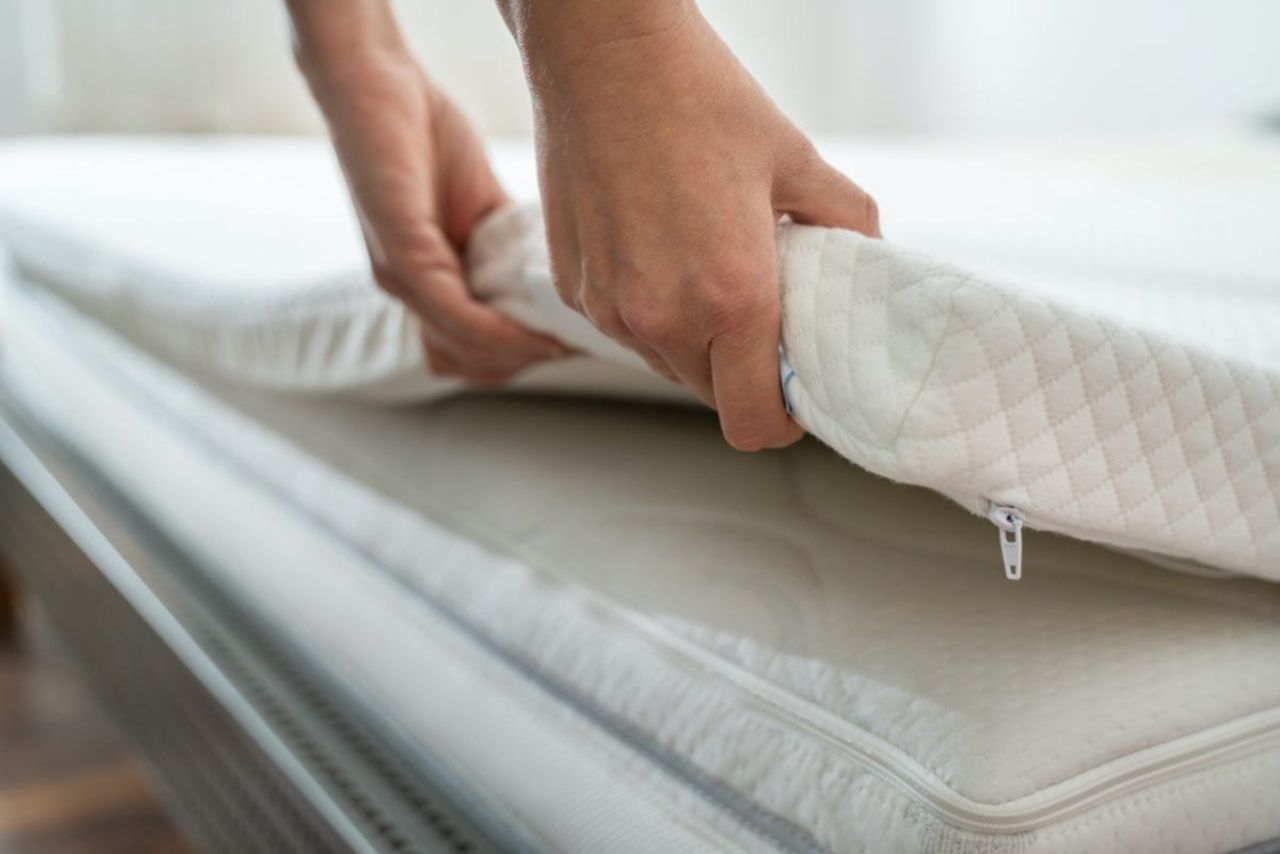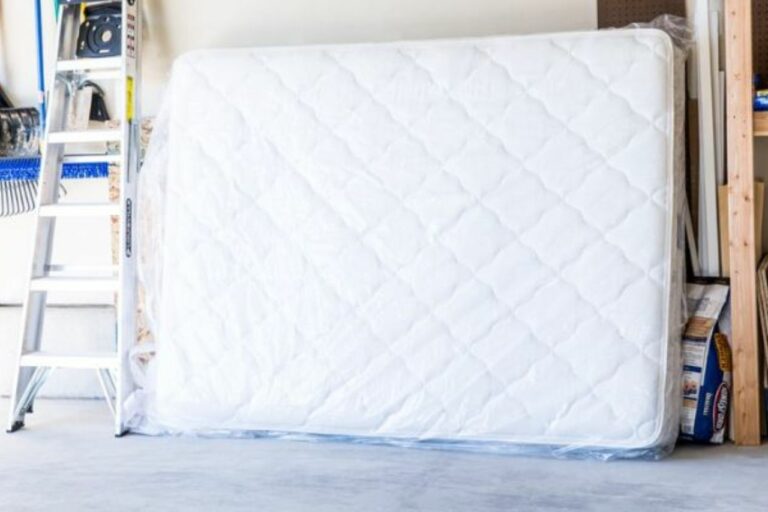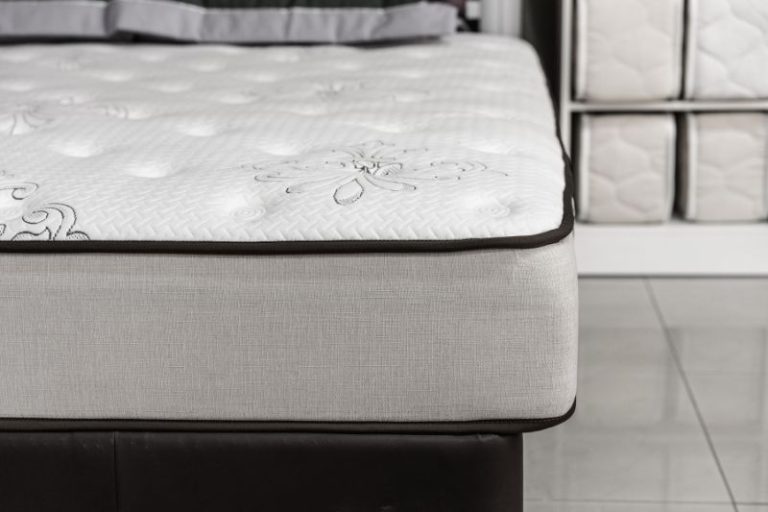How to Fix a Sagging Mattress? 5 Easy Steps to Fix!

Are you tired of tossing and turning on your sagging mattress?
If so, don’t worry there are ways to fix it!
In this article, we will explore simple yet effective methods for restoring your mattress’s support and comfort.
How to Fix a Sagging Mattress?
To remedy a sagging mattress, rotate and flip it, use a supportive mattress topper, or add plywood for reinforcement. For significant sagging, replacing the mattress could be the best solution.
So, if you’re wondering how to fix a sagging mattress, keep reading for some practical solutions that can help you get a good night’s sleep again.
One common cause of a sagging mattress is worn-out springs or foam.
Over time, these materials can lose their elasticity and fail to provide the necessary support.
To address this issue, one solution is to add extra support underneath the mattress.
Placing plywood boards or solid foundations between the mattress and the bed frame can help distribute weight evenly and prevent further sagging.
Additionally, using a mattress topper made from memory foam or latex can provide an extra layer of cushioning and support for your body while minimizing pressure points.
Remember that each person’s situation may be different when it comes to fixing a sagging mattress.
It’s important to assess your specific needs before deciding on the best course of action.
By implementing some of these techniques tailored to your circumstances, you’ll soon be able to enjoy rejuvenating nights with improved comfort and better spinal alignment.
What Causes a Sagging Mattress?
A sagging mattress can be a real pain, both literally and figuratively.
It not only affects the quality of your sleep but also the overall comfort and support provided by your bed.
Understanding what causes a sagging mattress is crucial in finding the right solution.
Here are some common culprits:
- Age: Over time, mattresses naturally wear out and lose their shape due to constant use. The materials compress, become less supportive, and start to sag.
- Low-Quality Materials: Inferior-quality mattresses often lack proper support structures or have inadequate padding materials that break down quickly. This can lead to premature sagging.
- Excessive Weight: If you regularly put excessive weight on your mattress, such as jumping on it or having heavy objects placed on it for an extended period, it can cause the internal components to weaken and eventually result in sagging.
- Improper Foundation or Bed Frame: Using an improper foundation or bed frame that doesn’t provide adequate support to the mattress can contribute to its sagging over time.
- Moisture Damage: Exposure to moisture from spills, accidents, or high humidity levels can compromise the integrity of certain types of mattresses (e.g., memory foam) leading them to lose their shape more easily.
- Lack of Rotation/Flipping: Neglecting regular rotation or flipping of your mattress may cause uneven wear patterns over time resulting in sagging around specific areas like where you usually sleep.
- Sleeping Position Habits: Consistently sleeping in one position every night will exert pressure on specific areas of the mattress causing them to degrade faster than others leading ultimately towards sagginess.
- Insufficient Center Support: For larger-sized beds like queen or king-size ones with inadequate center supports like slats or legs could make it prone toward sinking at mid-section over time.
By understanding the causes of a sagging mattress, you can take appropriate measures to prevent or alleviate the issue.
In the next section, we will discuss effective ways to fix a sagging mattress and restore its support and comfort.
Assessing the Level of Sag in Your Mattress
To effectively fix a sagging mattress, it’s essential to first assess the level of sag present.
Here are some steps to help you determine the severity of the issue:
- Visual Inspection:
- Remove all bedding and visually inspect your mattress for any noticeable signs of sagging.
- Look for visible depressions or unevenness in the sleeping surface.
- Pay attention to areas where you sleep most frequently.
- Physical Examination:
- Lie down on different sections of the mattress and feel for any sinking or uneven support.
- Move around and change positions to identify if certain areas have more pronounced sag than others.
- Measuring Sag Depth:
- Use a measuring tape or ruler to measure the depth of any visible sags.SAG DEPTHRECOMMENDATIONLess than 1 inch (2.5 cm)Minor sag, can often be improved with simple fixes like adding extra padding under specific areas.Between 1-2 inches (2.5-5 cm)Moderate sag, will likely require more substantial interventions such as using a mattress topper or considering professional repair options.More than 2 inches (5 cm)Severe sag, may necessitate replacing your mattress altogether for optimal comfort and support.
- Considerations Beyond Sag Depth:
- Take note of other factors that could contribute to discomfort such as lumps, coils poking through, or worn-out materials indicating overall wear and tear.
By carefully assessing the level of sag in your mattress, you’ll be better equipped to choose an appropriate solution based on its severity whether it requires minor adjustments, additional cushioning, repairs by professionals, or investing in a new mattress that suits your sleep needs.
Using Mattress Toppers to Improve Support:
If you’re dealing with a sagging mattress, using a mattress topper can be an effective solution.
Mattress toppers are designed to add an extra layer of cushioning and support, helping to alleviate the sagging and provide a more comfortable sleep surface.
Here’s how you can use mattress toppers to improve the support of your mattress:
- Choose the Right Type of Topper: There are various types of mattress toppers available in the market, including memory foam, latex, down alternative, and wool. Each type offers different levels of support and comfort. Consider your personal preferences and needs when selecting a suitable option.
- Measure Your Mattress: Before purchasing a mattress topper, measure the dimensions of your current mattress accurately. This will ensure that you choose the right size that fits snugly on top without any overhang.
- Select an Appropriate Thickness: Depending on how much additional support you require, consider the thickness of the mattress topper carefully. Thicker options generally offer more cushioning but might alter bed height or affect fitted sheets’ fit.
- Place it Directly on Your Mattress: Once you’ve chosen your desired type and thickness for the mattress topper, place it directly on top of your sagging mattress.
- Secure it in Place: To prevent slipping or shifting during sleep, secure your new addition by using fitted sheet straps or elastic bands specifically designed for this purpose.
- Consider Dual-Layer Toppers: If one layer doesn’t provide enough support or comfort for you, consider using dual-layered mattresses instead — combining two different types or thicknesses in one product could help address multiple concerns simultaneously.
Remember that while a quality mattress topper can enhance overall comfort and temporarily mitigate sagging issues caused by aging mattresses eventually replacing your old worn-out bed may be necessary for long-term improvement.
Using a mattress topper is an affordable and straightforward option that can extend the lifespan of your sagging mattress while providing you with better support for a more restful sleep experience.
Flipping and Rotating Your Mattress for Even Wear:
To fix a sagging mattress, one of the easiest and most effective methods is to flip and rotate it regularly.
This helps ensure even wear across the entire surface of the mattress.
Here’s how you can do it:
- Flipping your mattress: Most mattresses are designed to be used on both sides, so flipping them can help distribute the weight evenly. Follow these steps:
- Remove all bedding from the mattress.
- Carefully lift one end of the mattress while supporting its weight.
- Rotate it 180 degrees so that what was once at the head is now at the foot.
- Lower that end down gently, making sure it’s properly aligned with your bed frame or foundation.
- Repeat this process every three to six months.
- Rotating your mattress: If flipping isn’t an option because your mattress has different comfort layers on each side, rotating it is
Replacing the Box Spring or Foundation:
If your mattress is sagging, one possible solution is to replace the box spring or foundation.
Here are some steps you can take:
- Inspect the Box Spring or Foundation: Start by examining the box spring or foundation for any visible signs of damage, such as broken slats or springs. If you notice significant wear and tear, it’s likely time for a replacement.
- Measurements: Before purchasing a new box spring or foundation, measure the dimensions of your bed frame and mattress to ensure a proper fit. It’s important to get accurate measurements to avoid any compatibility issues.
- Choose a Suitable Replacement: There are various types of box springs and foundations available in the market, including traditional wooden frames with metal springs, adjustable bases with motorized features, and platform-style foundations made of solid wood or metal grids. Consider factors like comfort preferences, budget constraints, and specific needs before making your selection.
- Purchase from a Reliable Retailer: Look for reputable retailers that offer high-quality products backed by warranties or guarantees. Read customer reviews and check their return policies to make an informed decision.
- Follow Installation Instructions: When you receive your new box spring or foundation, carefully follow the manufacturer’s installation instructions provided with the product. Improper assembly may lead to further problems down the line.
- Dispose of Old Box Spring/Foundation Properly: To clear up space in your bedroom without contributing unnecessary waste to landfills, consider recycling options for disposing of your old box spring or foundation if they are no longer usable.
By replacing your worn-out box spring/foundation with a suitable alternative that provides adequate support for your mattress, you can help alleviate sagging issues and extend the lifespan of both your mattress and sleep quality overall.
Adjusting Your Sleeping Habits to Prevent Sagging:
To prevent your mattress from sagging, it’s important to make some adjustments to your sleeping habits.
Here are a few tips:
- Rotate and flip your mattress: Regularly rotate your mattress 180 degrees and flip it over every three months. This helps distribute the weight evenly and reduces the chances of sagging in specific areas.
- Use a supportive bed frame: Invest in a sturdy bed frame that provides adequate support for your mattress. Avoid using old or worn-out frames that may contribute to sagging.
- Maintain proper weight distribution: If you sleep alone, try alternating between different sides of the bed regularly. If you share the bed with a partner, consider using separate sleeping zones with their own mattresses to minimize pressure on one side.
- Avoid sitting on the edge of the mattress: Sitting or standing on the edge of a mattress can weaken its edges over time, leading to sagging. Instead, use chairs or benches for activities like putting on shoes or getting dressed.
- Use pillows appropriately: Ensure that you have appropriate pillow support for both your head and neck alignment while sleeping. Using too many pillows or placing them improperly can cause strain on certain areas of your body and potentially contribute to sagging.
- Consider body positioning: Try varying your sleeping positions throughout the night instead of consistently lying in one position for extended periods. This helps distribute pressure more evenly across different parts of your body.
Remember that these adjustments will help prevent further damage but may not completely reverse existing sags in older mattresses.
Replacing Worn-out Springs or Foam Layers:
If your mattress is sagging due to worn-out springs or foam layers, you can consider replacing them to restore its firmness and support.
Here are some steps to help you with the process:
- Identify the problematic area: Carefully inspect your mattress to locate the areas where the springs or foam layers have deteriorated and caused sagging.
- Measurements: Measure the dimensions of your mattress, including length, width, and thickness. This information will be helpful when purchasing replacement materials.
- Purchase replacement parts: Visit a reputable mattress store or online retailer that offers individual spring units or foam layers for mattresses. Ensure that you select high-quality materials that match the specifications of your existing mattress.
- Remove old springs/foam: If you’re replacing springs, carefully detach them from their housing using pliers or wire cutters as necessary. In case of foam layer replacement, use a utility knife to cut through any fabric covering before removing it.
- Clean and prepare the surface: Thoroughly clean any debris or residue left behind after removing old components from your mattress surface.
- Install new springs/foam: Place the new spring units in their designated locations within the mattress frame by following manufacturer instructions if available.
- For foam layer replacement:
- Trim down oversized replacements using a utility knife for an exact fit.
- Layer up multiple thinner foam pieces until desired thickness is achieved.
- Securely attach each layer together using adhesive spray specifically designed for mattresses.
- For foam layer replacement:
7-Reassemble: Once all replacements are properly installed and secured in place, reattach any fabric covers previously removed during installation process.
Remember that while replacing worn-out springs or foam layers can improve sagging issues temporarily, it may not completely fix underlying problems associated with an aging mattress structure such as weakened support systems or worn-out comfort layers.
If you consistently experience sagging despite these replacements, it might be time to consider investing in a new mattress altogether.
Seeking Professional Help for Severe Cases:
If your mattress is severely sagging and none of the DIY methods seem to work, it may be time to seek professional help.
Here are a few options you can consider:
- Contact the Manufacturer: If your mattress is still under warranty, reach out to the manufacturer. They may offer repair or replacement services depending on the terms of the warranty.
- Consult a Mattress Specialist: Look for professionals who specialize in mattresses or sleep systems. They have extensive knowledge and expertise in diagnosing and fixing various issues related to mattresses.
- Hire a Mattress Repair Service: There are companies that specifically deal with repairing and restoring mattresses. These experts will assess the condition of your mattress and provide suitable solutions
Conclusion: How to Fix a Sagging Mattress?
In conclusion, fixing a sagging mattress doesn’t have to be a complicated or expensive task.
By following the simple steps outlined in this article, you can restore your mattress’s support and comfort, giving it new life.
Firstly, identify the cause of the sagging by inspecting the mattress for any visible damage or worn-out areas.
Once identified, try rotating or flipping the mattress to distribute the weight evenly and reduce pressure on specific spots. Additionally, using a supportive mattress topper can provide extra cushioning and support.
If these initial steps don’t solve the issue, consider reinforcing your mattress with plywood boards or investing in specialized products like adjustable bed frames or firmness inserts.
These solutions can help alleviate sagging and extend your mattress’s lifespan.
Remember that prevention is key; regularly rotating and maintaining your mattress will help prevent future sagging. Lastly, if all else fails and your warranty allows it, consider contacting the manufacturer for repair or replacement options.







